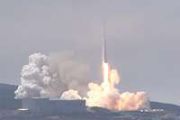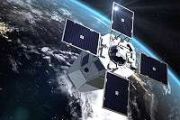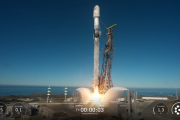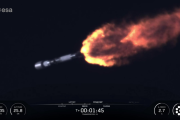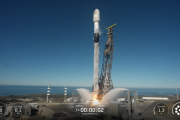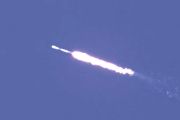
Copernical Team
Parker Solar Probe data bolsters theories in long-running solar riddle
 Data collected by NASA's Parker Solar Probe bolsters theories previously put by University of Michigan researchers about one of the sun's greatest mysteries-why its outer atmosphere is hotter than its fiery surface.
Two years ago, U-M engineers predicted when the probe would pass a constantly moving, invisible barrier in the sun's upper atmosphere called the Alfven point. They also anticip
Data collected by NASA's Parker Solar Probe bolsters theories previously put by University of Michigan researchers about one of the sun's greatest mysteries-why its outer atmosphere is hotter than its fiery surface.
Two years ago, U-M engineers predicted when the probe would pass a constantly moving, invisible barrier in the sun's upper atmosphere called the Alfven point. They also anticip SatRevolution Secures Series B Funding from Virgin Orbit
 SatRevolution S.A. has secured Series B funding from Virgin Orbit, the US-based responsive launch and space solutions company that has announced a planned business combination with NextGen Acquisition Corp. II. The Transaction values SatRev at approximately $150 million, and will support SatRev's business development.
The Transaction, signed at World Satellite Business Week, follows a stra
SatRevolution S.A. has secured Series B funding from Virgin Orbit, the US-based responsive launch and space solutions company that has announced a planned business combination with NextGen Acquisition Corp. II. The Transaction values SatRev at approximately $150 million, and will support SatRev's business development.
The Transaction, signed at World Satellite Business Week, follows a stra NASA enters the Solar atmosphere for the first time
 For the first time in history, a spacecraft has touched the Sun. NASA's Parker Solar Probe has now flown through the Sun's upper atmosphere - the corona - and sampled particles and magnetic fields there.
The new milestone marks one major step for Parker Solar Probe and one giant leap for solar science. Just as landing on the Moon allowed scientists to understand how it was formed, touching
For the first time in history, a spacecraft has touched the Sun. NASA's Parker Solar Probe has now flown through the Sun's upper atmosphere - the corona - and sampled particles and magnetic fields there.
The new milestone marks one major step for Parker Solar Probe and one giant leap for solar science. Just as landing on the Moon allowed scientists to understand how it was formed, touching Stellar "ashfall" could help distant planets grow
 The world's first 3D simulation simultaneously considering dust motion and growth in a disk around a young star has shown that large dust from the central region can be entrained by and then ejected by gas outflows, and eventually fall back onto the outer regions of the disk where it may enable planetesimal formation.
This process can be likened to volcanic "ashfall" where ash carried up b
The world's first 3D simulation simultaneously considering dust motion and growth in a disk around a young star has shown that large dust from the central region can be entrained by and then ejected by gas outflows, and eventually fall back onto the outer regions of the disk where it may enable planetesimal formation.
This process can be likened to volcanic "ashfall" where ash carried up b Closing in on the first light in the Universe
 Research using new antennas in the Australian hinterland has reduced background noise and brought us closer to finding a 13-billion-year-old signal
The early Universe was dark, filled with a hot soup of opaque particles. These condensed to form neutral hydrogen which coalesced to form the first stars in what astronomers call the Epoch of Reionisation (EoR).
"Finding the weak signal of thi
Research using new antennas in the Australian hinterland has reduced background noise and brought us closer to finding a 13-billion-year-old signal
The early Universe was dark, filled with a hot soup of opaque particles. These condensed to form neutral hydrogen which coalesced to form the first stars in what astronomers call the Epoch of Reionisation (EoR).
"Finding the weak signal of thi Super-bright stellar explosion is likely a dying star giving birth to a black hole or neutron star
 In June of 2018, telescopes around the world picked up a brilliant blue flash from the spiral arm of a galaxy 200 million light years away. The powerful burst appeared at first to be a supernova, though it was much faster and far brighter than any stellar explosion scientists had yet seen. The signal, procedurally labeled AT2018cow, has since been dubbed simply "the Cow," and astronomers have ca
In June of 2018, telescopes around the world picked up a brilliant blue flash from the spiral arm of a galaxy 200 million light years away. The powerful burst appeared at first to be a supernova, though it was much faster and far brighter than any stellar explosion scientists had yet seen. The signal, procedurally labeled AT2018cow, has since been dubbed simply "the Cow," and astronomers have ca Challenging Einstein's greatest theory with extreme stars
 Researchers at the University of East Anglia and the University of Manchester have helped conduct a 16-year long experiment to challenge Einstein's theory of general relativity.
The international team looked to the stars - a pair of extreme stars called pulsars to be precise - through seven radio telescopes across the globe.
And they used them to challenge Einstein's most famous theo
Researchers at the University of East Anglia and the University of Manchester have helped conduct a 16-year long experiment to challenge Einstein's theory of general relativity.
The international team looked to the stars - a pair of extreme stars called pulsars to be precise - through seven radio telescopes across the globe.
And they used them to challenge Einstein's most famous theo Solely European supply chain for space-qualified Alexandrite laser crystals on the horizon
 The European Union wants to use the unique properties of Alexandrite crystals in Earth observation satellites in the future. To make the EU independent of non-European suppliers, the Laser Zentrum Hannover e.V. (LZH), Altechna Coatings, and Optomaterials work on a purely European supply chain for space-qualified Alexandrite laser crystals in the EU project GALACTIC. The project partners have mad
The European Union wants to use the unique properties of Alexandrite crystals in Earth observation satellites in the future. To make the EU independent of non-European suppliers, the Laser Zentrum Hannover e.V. (LZH), Altechna Coatings, and Optomaterials work on a purely European supply chain for space-qualified Alexandrite laser crystals in the EU project GALACTIC. The project partners have mad Rocket Lab to acquire SolAero Holdings for its space solar power products
 Rocket Lab USA has signed a definitive agreement to acquire SolAero Holdings, Inc. (SolAero), a premier supplier of space solar power products and precision aerospace structures for the global aerospace market, for $80 million in cash. The acquisition is expected to close in the first quarter of 2022.
The acquisition aligns with Rocket Lab's growth strategy of vertical integration to deliv
Rocket Lab USA has signed a definitive agreement to acquire SolAero Holdings, Inc. (SolAero), a premier supplier of space solar power products and precision aerospace structures for the global aerospace market, for $80 million in cash. The acquisition is expected to close in the first quarter of 2022.
The acquisition aligns with Rocket Lab's growth strategy of vertical integration to deliv Sols 3326-3327: Backing away from the cliff
 As we continue exploring Maria Gordon notch, we are planning a touch and go with lots of remote sensing activities between the "touch" and the "go."
MSL is parked near the base of the cliff to the west, and the science team is interested in investigating the bedrock in this area.
Unfortunately, none of the bedrock targets shown near the top of the image above are suitable for close A
As we continue exploring Maria Gordon notch, we are planning a touch and go with lots of remote sensing activities between the "touch" and the "go."
MSL is parked near the base of the cliff to the west, and the science team is interested in investigating the bedrock in this area.
Unfortunately, none of the bedrock targets shown near the top of the image above are suitable for close A 

